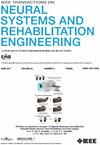有效,稳健,准确的CNN预测器神经元激活的定向深部脑刺激
IF 4.8
2区 医学
Q2 ENGINEERING, BIOMEDICAL
IEEE Transactions on Neural Systems and Rehabilitation Engineering
Pub Date : 2025-04-15
DOI:10.1109/TNSRE.2025.3561122
引用次数: 0
摘要
临床深部脑刺激(DBS)系统的编程涉及多种刺激参数的组合,如刺激幅度、脉冲宽度和频率。随着更复杂的电极设计,如定向电极的引入,传统的手动DBS编程的试错方法变得越来越不切实际。激活组织体积(VTA)的可视化可以通过显示DBS对神经组织的直接影响来帮助选择刺激参数。然而,VTA计算的标准方法涉及生物神经纤维建模,耗时长,限制了临床适用性。在这项研究中,我们使用植入DBS系统的有限元模型(FEM)来计算电场,并使用多室电缆模型获得了电刺激下轴突响应的大型数据集。然后,我们训练了一个卷积神经网络(CNN)来取代电缆模型。CNN模型在不同电极配置和刺激参数下计算VTA的性能进行了评估,并与现有的激活函数(AF)方法进行了比较。CNN模型预测神经纤维激活阈值的平均绝对误差(MAE)为0.032V,与AF方法相比,在VTA预测中表现出更高的稳定性和准确性。此外,与标准轴突建模方法相比,CNN将计算时间减少了五个数量级。我们证明了基于cnn的神经纤维预测器可以快速、准确、鲁棒地预测DBS的神经激活响应,从而提高DBS编程的效率。本文章由计算机程序翻译,如有差异,请以英文原文为准。
Efficient, Robust, and Accurate CNN Predictor for Neuronal Activation in Directional Deep Brain Stimulation
The programming of clinical deep brain stimulation (DBS) systems involves numerous combinations of stimulation parameters, such as stimulus amplitude, pulse width, and frequency. As more complex electrode designs, such as directional electrodes, are introduced, the traditional trial-and-error approach to manual DBS programming becomes increasingly impractical. Visualization of the volume of tissue activated (VTA) can assist in selecting stimulation parameters by showing the direct effects of DBS on neural tissue. However, the standard method for VTA calculation, which involves modeling biological nerve fibers, is highly time-consuming and limits clinical applicability. In this study, we used finite element models (FEM) of implanted DBS systems to compute electric fields and obtained a large dataset of axonal responses under electrical stimulation using multicompartment cable models. We then trained a convolutional neural network (CNN) to replace the cable models. The CNN model’s performance in calculating VTA was evaluated across various electrode configurations and stimulation parameters, and compared with existing activation function (AF) methods. The CNN model achieved a mean absolute error (MAE) of 0.032V in predicting nerve fiber activation thresholds, demonstrating greater stability and accuracy in VTA prediction compared to the AF method. Additionally, the CNN reduced computation time by five orders of magnitude compared to standard axonal modeling methods. We demonstrate that the CNN-based neural fiber predictor can quickly, accurately, and robustly predict neural activation responses to DBS, thereby improving the efficiency of DBS programming.
求助全文
通过发布文献求助,成功后即可免费获取论文全文。
去求助
来源期刊
CiteScore
8.60
自引率
8.20%
发文量
479
审稿时长
6-12 weeks
期刊介绍:
Rehabilitative and neural aspects of biomedical engineering, including functional electrical stimulation, acoustic dynamics, human performance measurement and analysis, nerve stimulation, electromyography, motor control and stimulation; and hardware and software applications for rehabilitation engineering and assistive devices.

 求助内容:
求助内容: 应助结果提醒方式:
应助结果提醒方式:


